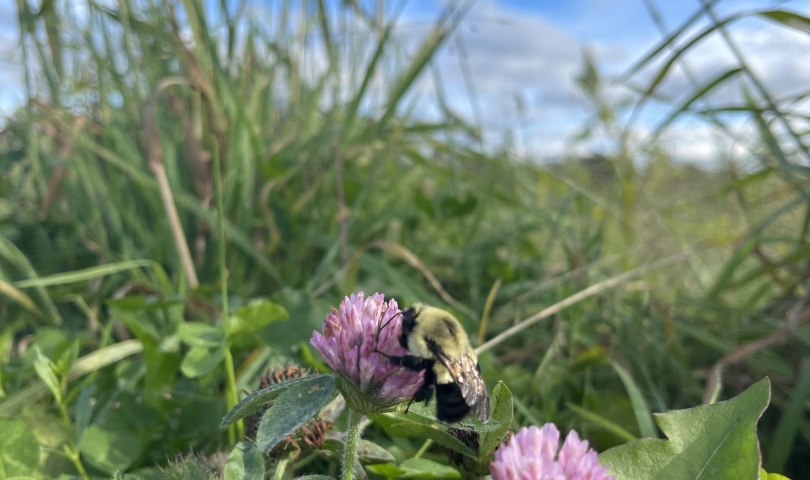We are in the peak of summer in the eastern upper peninsula, surrounded by breathtaking scenery and pristine bodies of water that are deeply intertwined with our culture and livelihoods. Landscapes of vivid greens and vibrant shades of blue are accented by fields of white, purple, and yellow flowers that draw not only our attention but that of pollinators too.
Pollinators encompass a variety of animals that source their food through flowers. Bats, birds, butterflies, moths, beetles, and of course bees, are drawn to the sugary sweet nectar of flowers that they drink for energy, and douse themselves in the granular pollen clusters that adhere to hairs or storage sacks on the creature’s bodies. Pollen, a powdery substance that contains the genetic material of a flower, is transferred to the reproductive organs of other nearby flowers by pollinators that visit one flower after the other. This mutualistic relationship helps flowers to successfully fruit to become more productive and resilient plants. Pollinators use the pollen as food for themselves and their young by mixing dry pollen with nectar to form pollen loaves that are left as initial nourishment for larvae in nests.
This vital group is being greatly impacted by habitat loss, fragmentation, use of pesticides, and drastically changing climates. Although this seems daunting, small changes can help pollinators sustain their declining populations and your gardens as well! To help them thrive, you can plant pollinator-specific gardens. Pumpkins, blueberries, cherries, and squash are plants native to Michigan that pollinators seek out as their favorite food sources, compared to common cultivar species that have been designed for their structure and blooms, and oftentimes lack the nectar that native pollinators seek out. Even one or two native plants like echinacea, rudbeckia, or lupine in your backyard or containers on your porch can act as a place of rest for pollinators. Great trees for pollinators include fruit trees, dogwoods, tulip trees, wild black cherry, common choke cherry, and chestnut trees. Native plant species tend to be perennial and low maintenance because they are naturally adapted to our climate. To create large-scale pollinator plantings, plan out and plant border habitats on fields, rivers, and gardens to provide spaces of rest to pollinators in between landscapes of towns and working agricultural lands.
Creating diverse pollinator gardens can reduce nuisance pest pressures, as the gardens tend to host more predators like spiders and birds that feed on pests throughout the habitat. Avoid the use of pesticides and chemicals as they can affect more than just the nuisance plants and pests you want to kill. If the only option, carefully adhere to the directions on the label and apply when pollinators are not active; right before dawn and after twilight. Other supportive practices include providing pollinators with sources of shallow, clean water. Hosting birdbaths, plates with rocks and water, and even upkeeping a mudpuddle throughout the season are excellent ways to provide fresh clean water to the workers in your landscape and provide many bee species with the clean mud they need to construct their nests. Creating bee hotels using wood, hollow paper tubes, bamboo, and reeds the size of drinking straws, masoned together with mud is an excellent way to mimic the natural structures of dried stalks and holes in trees created by insects and birds that pollinators use to nest. For our ground-nesting species, that dig tunnels in the earth to lay their larva in, it is important to minimize disturbances like tillage and excavation, to protect the structure of nests and their offspring.
We must all look out for one another, take care of the land we live and work on, and prioritize giving back to our pollinators, as they give so much to us. The next time you see a bird, bat, bee, or fly, thank them for the food on your table and for maintaining our unique ecology, culture, and heritage. Enjoy the beautiful bounty of the summertime in Northern Michigan, and always take the time to stop and smell your favorite native wildflowers, you can be a pollinator too!
By Melanie Chasseur, MAEAP Technician for the Chippewa Luce Mackinac Conservation District

- Keeping The Piece Quilters Guild to hold annual show in September - July 2, 2023
- District Court Report: April 20, 2023 - April 21, 2023
- Early Invaders of the Eastern Upper Peninsula - April 18, 2023



